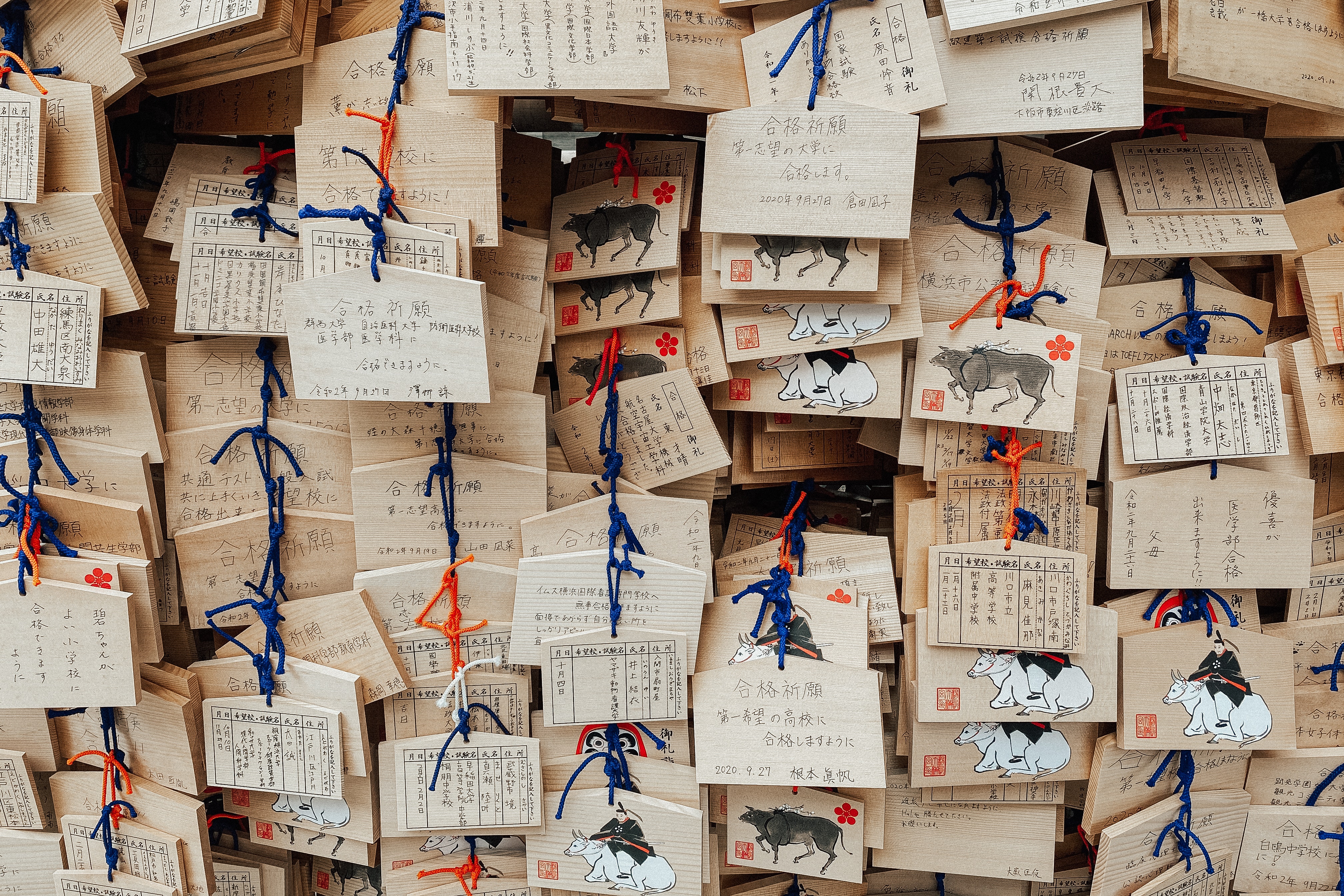
Kanji vs Chinese Characters: Surprising Similarities and Distinct Differences
Both Chinese and Japanese characters (also known as kanji) have inherited national aesthetics from a very long historical development of writing systems. Kanji vs Chinese characters are much more than writing; they are often approached as pieces of art. Although one can tell at a glance that kanji vs Chinese characters share a lot of similarities, they are two separate languages with different charms. Each opens us to a unique dialogue between cultures and inner conversation.
The early history of Chinese characters
More than 6,000 years ago, the earliest known form of Chinese writing was first invented in a small village near the Yellow River Valley. At that time, ancient Chinese people used writings to communicate with the spiritual realm, pray for blessings, and for protection from the spirits. The old Chinese characters, found on pottery vases, sherds, or tortoise shells, were derived from drawings of actual objects, so they have a strong visual connection with whatever they were representing.
The development from pictograms to ideograms used to convey abstract ideas took place between around A.D. 30–124. The first dictionary of Chinese was finally compiled, demonstrating that the written Chinese language was complete and remained relatively unchanged until today. In contrast to the way the Roman alphabet changed drastically to become highly abstract over time, the Chinese writing system still maintains a strong connection between the image of the original objects and the written characters. (Gunn, 2001).
The early history of kanji
It was not until the importation of Chinese writing in the Asuka (552–646 A.D.) and Nara (646–794 A.D.) periods that the Japanese had a fully elaborated and systematized writing system.
At that time, even though the pronunciation of these words was different, there was no difference between the kanji used in Japan and the Chinese characters. In other words, the basis of most kanji was formed from Chinese characters. Japanese people also used kanji in the same way as its original Chinese characters.
Japanese people then changed the meanings and invented new kanji for better use in their language. Therefore, kanji has gradually adopted different aesthetics from Japanese culture over time.
Similarities between kanji vs Chinese characters
- Nouns
It is estimated that the kanji vs Chinese writing systems have more than 80% of their characters in common. The most overlapping aspect of kanji and Chinese are nouns. Not only are they written mostly the same in both languages, their formats usually see no difference.
For example, Chinese and Japanese nouns do not have gender (masculine or feminine forms), unlike French or Spanish. They also keep their nouns unchanged regardless of singularity or plurality. Although in English, we have “a cat” as a singular noun and “cats” as a plural noun, those two phrases correspond to 猫 both in kanji and Chinese. Therefore, nouns in Japanese and Chinese are very easy to use.
On the other hand, you cannot know the gender and the number of objects by looking only at the nouns. So interpreting Chinese and Japanese is more difficult, since you need to consider the whole context.
- Numbers
Even though the numbers are pronounced differently in Japanese and Chinese, in written language, kanji vs Chinese characters representing numbers are exactly the same:
| Number | Kanji/Chinese characters | Chinese pronunciation | Japanese pronunciation |
| one | 一 | yi | ichi |
| two | 二 | er | ni |
| san | 三 | san | san |
| four | 四 | si | shi |
| five | 五 | wu | go |
| six | 六 | liu | roku |
| seven | 七 | qi | shichi |
| eight | 八 | ba | hachi |
| nine | 九 | jiu | kyu |
| ten | 十 | shi | jyu |
| a hundred | 白 | bai | hyaku |
| a thousand | 千 | qian | sen |
| ten thousand | 万 | wan | man |
Differences between kanji and Chinese
1. Different simplification systems
- Chinese simplified writing system
When the People’s Republic of China was established in 1949, the illiteracy rate was 80%. Acknowledging that traditional Chinese characters’ complicated strokes made Chinese acquisition very challenging, the government decided to simplify the writing system, primarily by either cutting down on strokes or merging the characters, with a view to promoting literacy and education.
| Traditional Chinese | Simplified Chinese |
| 語 | 语 |
| 說 | 说 |
| 話 | 话 |
There is another difference between the traditional and simplified writing systems. Whereas a single character expressed only one meaning in traditional writing, a simplified Chinese character may represent more than one word or concept. For example, 发 (simplified) means either 髮 (hair) or 發 (become/develop) in traditional Chinese.
There are nearly 2,000 traditional characters that were modified. Nowadays, simplified Chinese characters are used in mainland China, Singapore, and Malaysia. However, people in Hong Kong, Taiwan, and Macau still use the traditional Chinese writing system.
See more: Traditional vs. Simplified Chinese: Which one should you choose?
If you want to learn simplified Chinese characters using a fun and engaging method, you can count on Pandanese. It helps you remember new Chinese words with a perfect mnemonics system.
- Kanji simplified writing system.
Regarding the Japanese traditional writing system, similar to Chinese, the traditional kanji were very complex. Moreover, despite having identical meanings, several characters were written differently from each other, making things even more complicated. After World War II, the Japanese government started striving to minimize the number of kanji by choosing the most common ones and simplifying them by reducing the strokes. Many simplified kanji gradually appeared more in contemporary literature.
It is important to know that the Japanese do not use simplified Chinese radicals but their own simplification system instead, shinjitai (新字体). Accordingly, even though traditional kanji and Chinese were the same, simplified versions of both languages are quite different.
For example, the traditional Chinese character 圖(drawing) was simplified to 图, while in Japanese kanji, it was simplified to “図.” Or, the traditional character 鐵 (iron) was modified into 铁 in simplified Chinese and 鉄 in simplified Japanese. Most of the time, the simplified Japanese version is more intricate than the corresponding Chinese one.
2. Different meanings between some kanji and Chinese characters
Some characters were written completely the same in both languages but represent two different concepts. For example, the Chinese character 大丈夫 means a “man with responsibility”. However, in kanji the meaning is, “It does not matter” or “It’s okay.” Below are further examples:
Examples:
| Japanese kanji | Japanese meaning | Chinese character with the same meaning as the Japanese kanji | Meaning of the Japanese kanji in Chinese |
| 汽車 Kisha | train | 火車 (Huoche) | automobile |
| 聞 Kiku | to listen | 听 (Ting) in simplified Chinese聴 (Ting) in traditional Chinese | to smell |
| 結構 Kekko | well, fine | 相当 (Xiangdang) | structure, composition |
| 我慢 Gaman | endurance, tolerance | 忍耐 (Rennai) | I am slow (subject and predicate) |
3. Names and titles
While there are usually two (or at most three) characters in Chinese names, it is common that Japanese names consist of up to four characters. Additionally, kanji names can sometimes make Chinese natives misunderstand.
For instance, the Japanese word “Abiko,” which is written 我孫子 in kanji, is just the name of a place in Japan. However, in Chinese, 我孫子 is pronounced “wo sun zi,” meaning “my grandchild”. If a Japanese person tried to write “I come from Abiko” in Chinese, it then would turn out to be: 我来自我孫子. A Chinese speaker would be confused because they may think it meant “I come from my grandchild” (A real story from Arc communication)
In Chinese and Japanese, titles and professions must come after the surname in both languages. It’s worth mentioning that the word 先生 has different pronunciations and meanings in Chinese and Japanese. While it means “Mr” in Chinese, it refers to “Dr.” or “Professor” in Japanese.
4. More pictographs in Chinese than Japanese
As mentioned earlier about the origin of the Chinese language, Chinese writing originated as an attempt to create pictures of specific objects and actions, resulting in a great number of pictographs. So we can say that Chinese writing came before spoken language.
Even though the original pictographic form is of course still present in the Japanese writing system, kanji characters are just a way of writing the Japanese pre-existing verbal form. Japanese kanji characters are meant to express and visualize the sounds of a language that was oral before it was written. That’s how the Chinese culture contributed to the Japanese writing system: helping the Japanese write what was already being spoken.
So many kanji radicals are ideograms. As well as kanji characters of Chinese origin, the Japanese writing system uses two more types of characters called hiragana, and katakana to evoke Japanese spoken language.
5. Made-in-Japan kanji characters
In addition to modifying some of the original Chinese characters for better use in their language, the Japanese also came up with new native Japanese characters are called kokuji (国字 – national characters) or wasei kanji (和製漢字 – kanji made in Japan). Most of these characters refer to things in Japan that do not exist in China, such as fish and plant species that are peculiar to Japan.
There are at least four hundred kokuji in today’s Japanese writing system, although only a few of them are used on a regular basis. Kokuji characters are usually combinations of two kanji radicals. For example, two radicals 辶 (road) and 入(to enter) are slapped together to make a new kanji character 込 (crowded). Below is a list of the most commonly used kokuji:
| Kanji | On (Chinese reading) | Kun (Japanese phonetic reading) | Meaning |
| 働(く) | ドウ | はたら.く | Job |
| 込(む) | こむ、こめる | Crowded, mix, by volume | |
| 搾(る) | サク | しぼる | Squeeze, juicer |
| 峠 | とうげ | Mountain peak, mountain pass, climax, ridge | |
| 畑 | はた、はたけ | Farm, field, garden | |
| 塀 | ヘイ | へい | Fence, wall, wall |
| 腺 | セン | せん | Gland |
| 辻 | つじ | Crossing, corner, crossroads, street | |
| 匂(う) | にお.う, にお.い, にお.わせる | fragrant, smell l |
The bottom line
At the end of the day, Chinese and Japanese are both beautiful as each language demonstrates the varied aesthetic values of each country’s national language and culture. Understanding the differences between kanji vs Chinese will no longer be a challenge as long as you keep the given tips in hand.
Pandanese is a web-based Mandarin learning platform that enables users to master 6,000 hanzi Chinese characters a year. Our one-of-a-kind curriculum is designed to support various learning purposes: school, business, travel. So, whatever you’re learning Chinese for, Pandanese got you covered!
Sign up now and learn Chinese for free!
The easiest way to learn Chinese & build vocabulary

